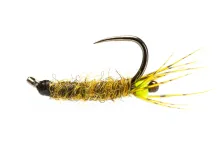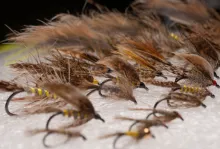While keeping the profile of the Copper John but using fewer and different materials the Glitter John came about.
I first tied up the Glitter John a couple of years ago after coming home from a regional fly tying show with some oddball materials which included a spool of glitter thread. While sitting at my tying bench the next evening I was staring at a row of Copper Johns in my fly box when I got the idea that I should try to incorporate some newer materials into an older, proven pattern. While keeping the profile of the Copper John but adding some different materials the Glitter John came about and a few were thrown in a corner of my fly box.
Fishing
Later that summer I got the chance to go to Colorado and give the Glitter John its first real test. It not only caught fish but it kept up with any other nymph pattern I tried which has earned it a permanent spot in my fly box. My favorite way to fish this pattern is on a dry dropper rig under a larger attractor dry but it will also work in a more standard double nymph indicator rig. I've had the most success fishing this pattern on small mountain creeks to medium sized rivers that feature lots of riffles and smaller runs but this fly should work anywhere where trout will take a small flashy nymph.
Finding the thread
The thread is the most important part on this fly because it is also the body material but unfortunately the thread I use is extremely difficult to find. This thread is called Pro Tyer and if you can find some its good stuff but its hard to find to the point that a quick google search doesn't even turn up results. Luckily though there are a couple great substitutes that will work just as well. The first of which is Midge Body Thread from Montana Fly Company and as far as I can tell its the exact same product. If you can't get MFC products or just want to try something a little different the other option is Iridescent Thread from Veevus. The colors are a little different but it should still produce a good looking fly.
|
|
|
|
|
|
|
|
|
|
|
|
Overall the Glitter John is a fairly easy tie and has been a good pattern for me wherever I've used it so tie some up and give them a try!
Adam Urban
- Log in to post comments
























You can buy the glit
You can buy the glitter thread you need at canadianllama.com
another option for t
another option for the body is gutermann sulky holoshimmer thread
Mike,
I've tr
Mike,
I've tried using Krystal Flash for the body and it does make a nice fly but its also a little less durable so I'd include some wire ribbing as well.
You could also try u
You could also try using Krystal Flash for the body strands. Midge flash for smaller bodies would work as well for finer bodies. Yet another idea is midge diamond braid. Some depends on what you want for the bodies...